API flows
PSP - debit flow
The payment service provider needs to implement a debit endpoint for the Partner API to make the initial debit request.
The endpoint that the payment service provider needs to expose must be in the following format:
https://{{payment-service-provider-host}}/v1/debit
User interfaceThe payment service provider is responsible for managing the user interface for the payment.
Related Resources
🔑 Payment service provider - authenticate in Peach
📖 Payment service provider - handle the debit request
Debit steps:
- The user chooses to pay using a payment service provider on the merchant website.
- The Partner API sends a debit request to the payment service provider.
- The payment service provider responds with the redirect URL where the user interface for the payment service provider platform is hosted. In the response, the result code should be 000.200.000 if successful.
- The payment service provider's user interface is either displayed in an iFrame for Checkout or as an iFrame or full redirect for Payments API for the user to interact with. The payment service provider's user interface widget is displayed on the merchant's site for the user to interact with. During this step, all interactions with the user, for example, capturing second-factor authentication information like OTP, continues in the user interface screens between the user and the payment service provider. The Checkout plugins integration guidelines section describes best practices on how to ensure that the user interface is rendered correctly in e-commerce plugins.
- The user submits the relevant information to the payment service provider for validation and fulfilment of the payment.
- The payment service provider redirects back to the
shopperResultUrlwith the unique ID. - The Partner API sends a transaction status request to the payment service provider.
- The payment service provider responds with the final status of the transaction: 000.000.000 for success in LIVE, and 000.100.110 for success in TEST.
- The Partner API sends the final status of the transaction to the merchant.
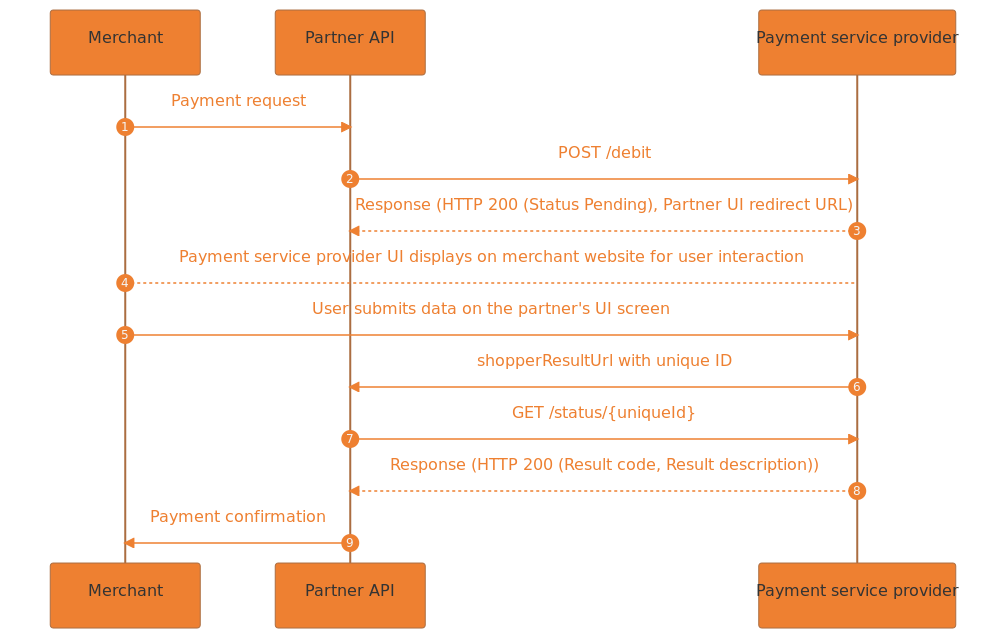 Debit payment flow.
Debit payment flow.
PSP - refund flow
If a refund option is provided by the payment service provider, they must implement the refund endpoint provided by the Partner API to process refund transaction requests from the merchant.
The endpoint that the payment service provider needs to expose must be in the following format:
https://{{payment-service-provider-host}}/v1/refund/{debitUniqueId}
Both full and partial refunds are supported by the Partner API.
NoteIf the payment service provider does not support:
- Refunds, they should respond with a 404 HTTP status code for refund requests.
- Partial refunds, they should respond with the 900.100.202 result code for partial refund requests.
Related Resources
🔑 Payment service provider - authenticate in Peach
Refund steps:
- The merchant initiates a refund request.
- The Partner API sends a refund request to the payment service provider.
- The payment service provider sends the refund response to the Partner API. The 700.400.200 result code should be used if the refund amount exceeds the original debit amount.
- The Partner API sends the refund response to the merchant.
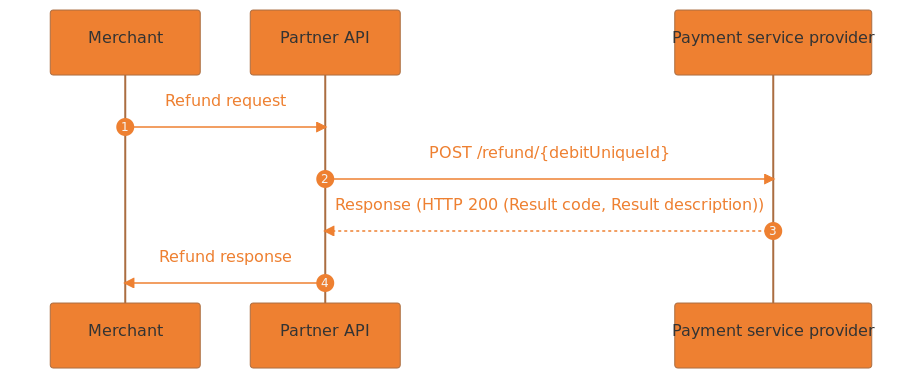 Refund flow.
Refund flow.
Partner API - webhook flow
The payment service provider must send a webhook to the Partner API whenever a transaction status event occurs.
A transaction status event refers to whenever the status of the transaction being processed changes, for example, from a pending status to a failed or successful status.
See the API reference section for sample webhook requests.
Related Resources
🔑 Payment service provider - authenticate in Peach
🦉 Payment service provider - sending webhooks
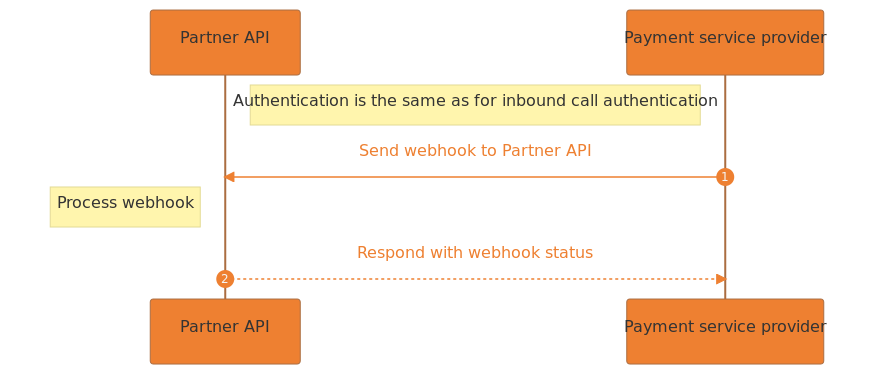 Webhook flow.
Webhook flow.
PSP - transaction status flow
A transaction status endpoint must be implemented by the payment service provider in order to allow the Partner API to query the transaction status at any given point in the transaction life cycle.
This endpoint is called when the Partner API needs to query the status of a specific transaction. The Partner API sends a unique ID and the payment service provider must respond with the details of the transaction linked to that ID.
The endpoint that the payment service provider must expose must be in the following format:
https://{{payment-service-provider-host}}/v1/status/{uniqueId}
Related Resources
🔑 Payment service provider - authenticate in Peach
📖 Payment service provider - handle the status request
Transaction status steps:
- The Partner API sends a transaction status request with a unique ID to the payment service provider.
- The payment service provider responds with the details of the transaction linked to the unique ID.
- The Partner API sends the transaction status to the merchant.
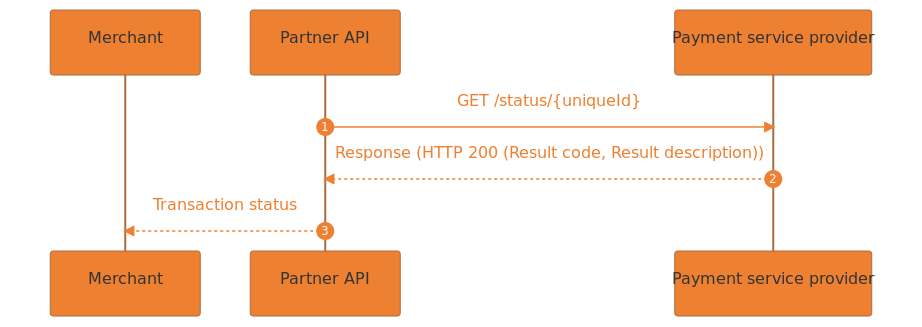 Transaction status flow.
Transaction status flow.
PSP - transaction cancel flow (Optional)
The Partner API supports an optional transaction cancelation endpoint. This endpoint can be used by payment service providers who require users to explicitly cancel a pending transaction.
The endpoint is limited to canceling pending transactions and cannot be used to reverse successful transactions.
The endpoint that the payment service provider must expose must be in the following format:
https://{{payment-service-provider-host}}/v1/cancel/{uniqueId}
You can also choose to allow customers to cancel the transaction through the Checkout instance as described in the Checkout plugins integration guidelines (see step 5).
Related Resources
🔑 Payment service provider - authenticate in Peach
Transaction cancel steps:
- The user chooses to pay using a payment service provider on the merchant website.
- The Partner API sends a debit request to the payment service provider.
- The payment service provider responds with the redirect URL where the user interface for the payment service provider platform is hosted.
- The payment service provider user interface widget is displayed on the merchant's site for the users to interact with. During this step, all interactions with the user, for example, capturing second-factor authentication information like OTP, continues on the user interface screens between the user and the payment service provider.
- The user clicks cancel on the merchant website to cancel the transaction.
- The Partner API sends a POST
/cancel/{uniqueId}request to the payment service provider. - The payment service provider processes the request and responds to the Partner API with the appropriate result code - 100.396.101 if successful.
- The Partner API sends the final cancel status response for the transaction to the merchant.
NoteA 404 HTTP status code should be returned if a cancel request is initiated and the payment service provider does not support cancel functionality.
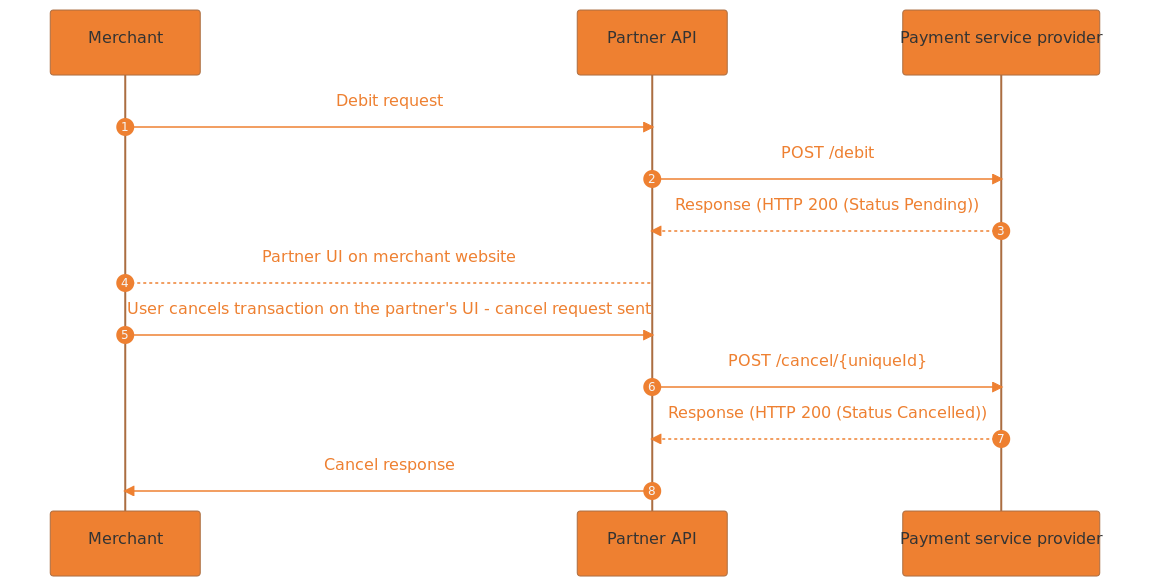 Transaction cancel flow.
Transaction cancel flow.
Updated 4 months ago